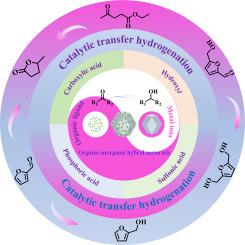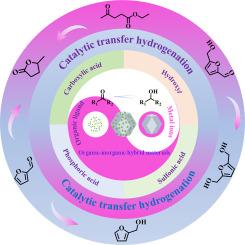用于催化生物质衍生含羰基化合物转移加氢的有机-无机杂化材料
IF 23.5
1区 化学
Q1 CHEMISTRY, INORGANIC & NUCLEAR
引用次数: 0
摘要
将生物质衍生的平台分子升级为有价值的化学品和生物燃料,对于生物精炼厂建立以生物为基础的可持续化学工艺至关重要。催化转移加氢是生物基含氧化合物还原升级的一个令人着迷的策略,因为它绕过了与使用易燃易爆加压 H2 相关的潜在安全风险和繁琐的安全预防措施。有机-无机杂化材料(OIHMs)具有路易斯酸碱能力强、比表面积和孔径大、结构/性能可调、易于制备等优点,已被证实是很有前景的转移加氢催化剂。本文概述了 OIHMs 在生物含氧化合物转移加氢中的应用,主要涉及多种富含 -OH、-COOH、-PO3H2 和 - SO3H 等含氧基团的有机配体,用于构建 OIHMs。此外,还阐明了相应的表征手段,以明确 OIHMs 的结构/性质、结构-反应关系、反应途径和/或机理以及催化剂的耐久性。此外,还讨论了 OIHM 在转移加氢中应用的一般挑战和未来研究。希望本综述能为 OIHMs 在通过氢转移过程还原升级生物基含氧化合物中的合理设计和实际应用提供指导性观点。本文章由计算机程序翻译,如有差异,请以英文原文为准。


Organic-inorganic hybrid materials for catalytic transfer hydrogenation of biomass-derived carbonyl-containing compounds
Upgrading biomass-derived platform molecules into valuable chemicals and biofuels is critical in bio-refinery to establish bio-based sustainable chemical processes. Catalytic transfer hydrogenation represents a fascinating strategy for the reductive upgradation of bio-based oxygenated compounds owing to bypassing the potential security risks and tedious safety precautions associated with using flammable and explosive pressurized H2. Organic-inorganic hybrid materials (OIHMs), bearing the merits of strong Lewis acid-base ability, high specific-surface-area and pore size, tunable structure/properties and easy preparation, have been confirmed to be promising catalysts for transfer hydrogenation. In this contribution, an overview of OIHMs in transfer hydrogenation of bio-based oxygenated compounds is presented, which mainly involves diverse organic ligands with oxygen-rich groups like −OH, −COOH, −PO3H2, and − SO3H for constructing OIHMs. The corresponding characterization means for clarifying the structures/properties of OIHMs, structure-reactivity relationships, reaction pathways and/or mechanisms together with catalyst durability are elucidated. In addition, the general challenges and future research on the applications of OIHMs in transfer hydrogenation are also discussed. Expectedly, this review can provide an instructive viewpoint for the rational design and practical application of OIHMs in reductive upgrading of bio-based oxygenated compounds via hydrogen transfer processes.
求助全文
通过发布文献求助,成功后即可免费获取论文全文。
去求助
来源期刊

Coordination Chemistry Reviews
化学-无机化学与核化学
CiteScore
34.30
自引率
5.30%
发文量
457
审稿时长
54 days
期刊介绍:
Coordination Chemistry Reviews offers rapid publication of review articles on current and significant topics in coordination chemistry, encompassing organometallic, supramolecular, theoretical, and bioinorganic chemistry. It also covers catalysis, materials chemistry, and metal-organic frameworks from a coordination chemistry perspective. Reviews summarize recent developments or discuss specific techniques, welcoming contributions from both established and emerging researchers.
The journal releases special issues on timely subjects, including those featuring contributions from specific regions or conferences. Occasional full-length book articles are also featured. Additionally, special volumes cover annual reviews of main group chemistry, transition metal group chemistry, and organometallic chemistry. These comprehensive reviews are vital resources for those engaged in coordination chemistry, further establishing Coordination Chemistry Reviews as a hub for insightful surveys in inorganic and physical inorganic chemistry.
 求助内容:
求助内容: 应助结果提醒方式:
应助结果提醒方式:


